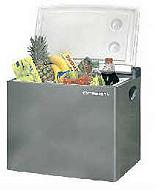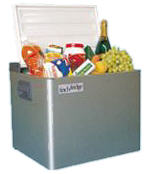|
exploring
3way fridges
The aim of this article is to explore the working principal of a three way
fridge in order to understand and perhaps prevent problems that may occur.
To make it easier to understand the following I remind you that cold does not
exist and can not be measured. Cold is an emotion that you feel when heat is
removed. The absolute temperature of everything is 0 deg. Kelvin = -273.15
deg. C. so I will talk about removing heat, not making cold.
how it works
Basically a three way fridge works on what is known as the Absorption
principal. Dalton's Law of partial pressures is the foundational operating
principle of absorption type refrigerating systems. The absorption
refrigerator requires the application of heat to start things happening. This
is where the term three way comes from, three ways of providing that
necessary heat.
1. 12volt, using a small heating element.
2. 240volt, also using an appropriate heating element.
3. Gas, using a small gas flame.
There are therefore four quite separate systems used to make up this compete
unit.
 1. 12volt heating system. 1. 12volt heating system.
2. 240volt heating system.
3. Gas heating system.
4. Fully sealed absorption system.
Most of the variations from one refrigerator to another will be:
1. Cosmetic - what it looks like and it’s style.
2. Efficiency - how well the cabinet is insulated.
3. Capacity - the cabinet size.
4. Load - amount of heat/cooling to be provided.

A typical three way fridge would be about 30 – 40 litres
capacity with about 75watt heating elements for both 12v & 240v. Perhaps a
thermostat for temperature control on 240v only and either an on/off or two
step manual control for gas.
Note. 75 watt on 12v will be a load of 6.25 amps. Gas usage would be about 1kg /
week.
Generally the load will be greater when run on gas.
The three heating systems are quite independent and one only should be used at
any time.
The absorption system is fully sealed and generally
considered not to be repairable. However unless it is physically damaged it is
unlikely to ever fail.
These refrigerators have what is commonly referred to as a furnace. The
furnace can be identified as the only part of the “works” which is insulated
to keep the heat in and has a small flue out from the top. This is where all
of the heating takes place housing the ‘generator’ & ‘separator’ that will be
referred to later, also this is where the gas burner and each of the heating
elements are located.
These refrigerators use ammonia as their refrigerant,
assisted by water and hydrogen to continuously cycle the ammonia. The
refrigerator has five main components, ref to the drawing:
1. Generator - generates ammonia gas
2. Separator - separates ammonia gas from water
3. Condenser - where hot ammonia gas is cooled and condensed
to create liquid ammonia
4. Evaporator - where liquid ammonia evaporates removing heat
from inside the cabinet.
5. Absorber - where water absorbs the ammonia gas.
basic cycle
 raises the temperature
of the solution until the ammonia boils. raises the temperature
of the solution until the ammonia boils.
The boiling solution rises to the separator (as in a coffee
percolator). In the separator, water separates from the ammonia gas.
The ammonia gas flows upward to the condenser. The condenser is composed of
metal coils with fins that allow the ammonia gas to dissipate its heat and
condense to form liquid ammonia. The liquid ammonia makes its way to the evaporator, where it mixes with
hydrogen and evaporates, removing heat from inside the refrigerator cabinet.
The mixture of ammonia and hydrogen gases flows to the absorber.
Here, the water that has spilled from the separator is mixed with the ammonia
and hydrogen mixture. Ammonia readily mixes with water and returns to the
generator while the hydrogen does not mix, so is separated for return to the
evaporator.
And so the cycle continues as long as heat is provided in the furnace.
keeping it level
You
will notice that in my drawing I have shown the components generally with a
vertical orientation (I took the easy way out) where as in reality at least
some items are usually horizontal.

One problem that is often spoken of is the need to ensure the fridge is level.
While this is important it is not critical a few degrees either way is
generally ok. I have a small bull’s eye level mounted on the fridge and find
it a convenient way to check.
You soon get to know how level it must to be. When the unit is not level the
various liquids do not circulate correctly this causes the cycle to stop. I
have never had a problem while travelling whether up hill or down the movement
of the vehicle seems to be sufficient to maintain correct circulation.
There was a time years ago when if an absorption fridge was tilted over and
stopped working it was necessary to go through a procedure of specific
movements, including upside down before you could get it working again, I have
not experienced this for many years now.
about mine
Mine was pre-loved when I got it over 20 years ago. It is used mainly on gas
(camp) or 240v travelling). I have had to clean the gas jets once but normally
it just goes and goes. I am very satisfied with it. I have recently fitted
computer fans to the cabinet in which it travels but this has not been tried
yet in hash conditions.
I hope you get some thing of help from this.
thanks to Ian Wilkin
|